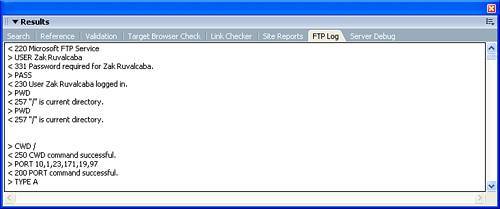| Although it seems we've run the gamut in terms of site management functionality, Dreamweaver actually includes a few more features that can only be categorized as advanced site management options. Available from the Advanced submenu in the Site menu, these advanced features include the following: FTP Log: While transferring files using the built-in FTP client, Dreamweaver records all activity. If an error occurs when you are transferring a file using FTP, the FTP log can help you determine the problem. Simply select this option to present the text-based log in the FTP Log tab in the Results window similar to Figure 4.42. Figure 4.42. The FTP log can help you troubleshoot FTP errors. 
Recreate Site Cache: At the beginning of the chapter, we discussed the cache. I mentioned that Dreamweaver takes a snapshot of your folder and file structure and caches it. In most cases, this cache is automatically generated and in some cases, when changes are made in Dreamweaver, the cache is regenerated. If, for some reason, you make changes to the folder and file structure outside of Dreamweaver (not recommended), run this handy utility to re-create Dreamweaver's cache for the selected site. Remove Connection Scripts: When connecting to databases, Dreamweaver relies on a connection script built into a file and placed within a Connections folder in your site. If you've begun working with databases, this file is automatically created for you. Unfortunately, Dreamweaver doesn't know when you're no longer working with databases. You can minimize the risk of someone accessing your database remotely by removing these connection scripts manually. Because compromise is possible only while the scripts are actually present on the server, removing the scripts removes the risk of database access in the future. Deploy Supporting Files: When working with dynamic web applications, Dreamweaver relies on pre-built files and scripts (like connection scripts) to create the functionality with which you'll ultimately interact. In most cases, Dreamweaver automatically creates a folder within your site for these files. If, for some reason, the folder isn't created, you can select this option to force Dreamweaver to do so. This option is covered in more detail in Part V, "Dynamic Web Page Development."
|
